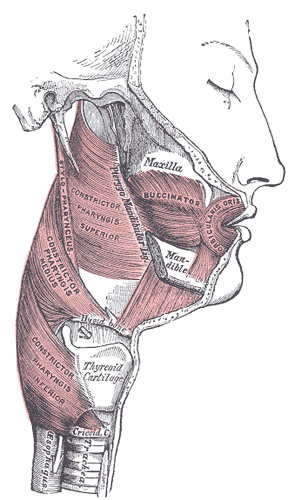Anatomical boundaries
The parapharyngeal space is shaped like an inverted pyramid. Lateral and inferior to the parapharyngeal space is the carotid sheath, containing the internal carotid artery and cranial nerves IX, X and XI. Behind both the parapharyngeal space and carotid space lies the retropharyngeal space, and deep to this a potential space known as the danger space. The danger space serves as an important pathway for complicated infections of the posterior pharynx to enter the chest and spinal column. Anterior to the parapharyngeal space is the masticator space which contains the lower dental row, muscles of mastication, the inferior alveolar nerve as well as branches of cranial nerve V. Lateral to the parapharyngeal space lies the parotid space, which contains the parotid gland, the external carotid artery and cranial nerve VII. [1] Although initial evaluation is typically by physical exam and endoscopy, follow up with CT and MRI usually is needed if surgical intervention is planned. [2]
Bony anatomy around the space includes the skull base superiorly, and the greater cornu (or greater horns) of the hyoid bone the apex, inferiorly. The superior aspect is the base of skull, namely the sphenoid and temporal bones. This area includes the jugular and hypoglossal canal and the foramen lacerum (through which the internal carotid artery passes superiorly across).
The medial aspect is made up of the pharynx. Anteriorly it is bordered by the pterygomandibular raphe. Posteriorly it is bordered by carotid sheath posteriolaterally and the retropharyngeal space posteriomedially. The lateral aspect is more involved, and is bordered by the ramus of the mandible, the deep lobe of the parotid gland, the medial pterygoid muscle, and below the level of the mandible, the lateral aspect is bordered by the fascia of the posterior belly of digastric muscle. These anatomical boundaries make it continuous with the retropharyngeal space. It also communicates with other cervical and cranial fascial spaces, as well as the mediastinum.
This page is based on this
Wikipedia article Text is available under the
CC BY-SA 4.0 license; additional terms may apply.
Images, videos and audio are available under their respective licenses.

